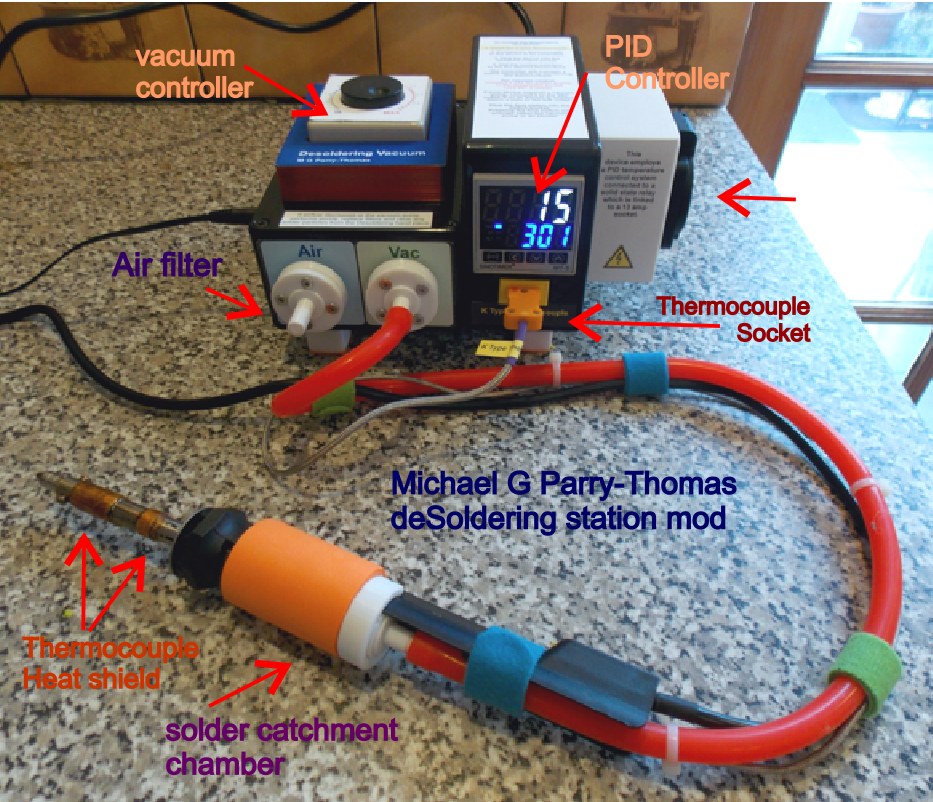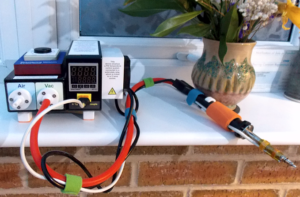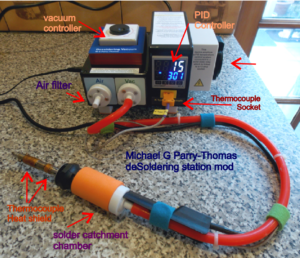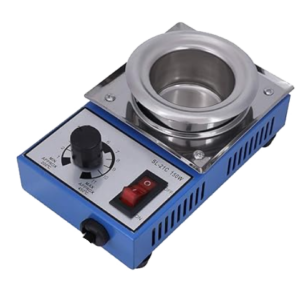
PID temperature control

Recently, I encountered a situation that required me to have a desoldering station. There are various types available for purchase, ranging from a simple desoldering pump costing about £8 to professional units priced at £800 or more. The pricier units offer temperature control for the hand tool and some even allow adjustment of the vacuum suction. Additionally, they come with different filtration systems to collect solder in the hand tool. Generally, with this type of equipment, what you pay for is what you get, and reputable brands typically provide trouble-free performance for many years. Some units may be more advanced than necessary, but I aimed to create a desoldering station with quality and control comparable to higher-end models. To achieve this, I opted for a PID temperature controller commonly used in kilns and heating ovens. One challenge was how to place a temperature probe on a heating element reaching temperatures as high as 400 degrees, where ceramic kiln materials came in handy due to their various types like ceramic fibers and papers that can be utilized in such projects.
For most hobbyists, a simple soldering iron coupled with a basic desoldering pump suffices for minor repairs. I have several modules in need of upgrade or repair for my weather station. Given my positive experience with a PID controller in my test kiln, I decided to use one for this project as well. I acquired a basic PID controller from eBay that proved to be very accurate in temperature control within 2 to 3 degrees using the auto-tune function.
Next, I needed a reliable vacuum pump, which I procured from eBay and was satisfied with its performance. I then adjusted the vacuum pump pressure by incorporating a speed controller for the DC motor to regulate the airflow. For the hand tool, I purchased an affordable desoldering heated hand tool that allowed for attachment of a vacuum to draw solder into a chamber. It required a basic modification to function properly. I integrated all components into small boxes starting with the vacuum pump, followed by fitting a DC supply socket and mounting a PID controller in the next box. The PID controller required 240 volts AC, and by bolting the two boxes together, I created isolation between the low-voltage and high-voltage components.
To control the temperature more accurately, I installed a solid-state relay instead of a contact relay. The solid-state relay pulses to provide precise control based on output from the PID controller, gradually adjusting the power to maintain temperature within the desired range. During assembly of the hand tool, I secured a thermocouple to the heating element using ceramic fiber paper and high-temperature tape for effective heat transfer.
The subsequent step involved designing 3D parts for the vacuum pump inlet and outlet with the intention of incorporating a filter for extending the vacuum pump’s lifespan.
Following that, the focus shifted towards devising a method to install the vacuum control speed unit. This was accomplished by fabricating an external box through 3D printing. Additionally, the socket box was also 3D printed to accommodate the power output controller socket, which connects the desoldering heating tool and is managed by the PID system.
I found great pleasure in working on this project as it involved implementing various concepts utilized in ceramic kiln operations, such as temperature control of the tool and addressing challenges associated with attaching the thermocouple using ceramic paper fiber materials, which could have made the task more challenging.

150W Solder Pot mod

The output controller connects to the solid state relay, which then links to a power outlet, making it convenient for adding extra tools.
I purchased a solder melting pot, useful for desoldering components, wire end coating, and casting low-temperature alloy. This product can be bought on eBay for about £12. If you plan to get one, I recommend having the cable, plug, and circuit board checked. The cable was not suitable and the plug was not appropriate for UK use. Although some of these devices include adapters, I advise against their use. After inspection, I chose to replace the cable and connections to the small circuit board, along with using heat shrink tubing on all connections. Ensuring proper grounding of the earth cable was crucial, as the grounding point was painted upon close examination. The solution involved removing the paint from the metal, reattaching the earth cable, and conducting a PAT test.
For the main project, enhancing the solder melting pot by adding a thermocouple, which could then link to my desoldering station controller, allowing for more precise temperature control, is a possibility. The main project build’s thermocouple utilizes a K type thermocouple.





